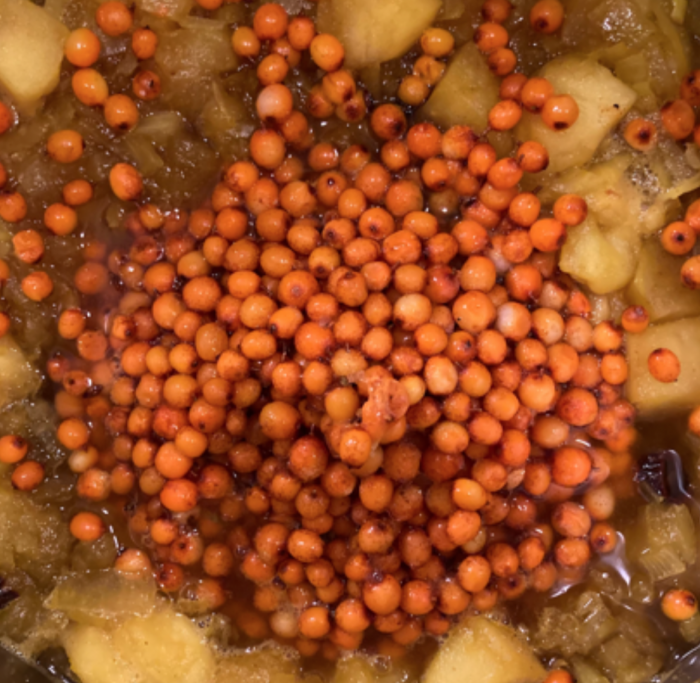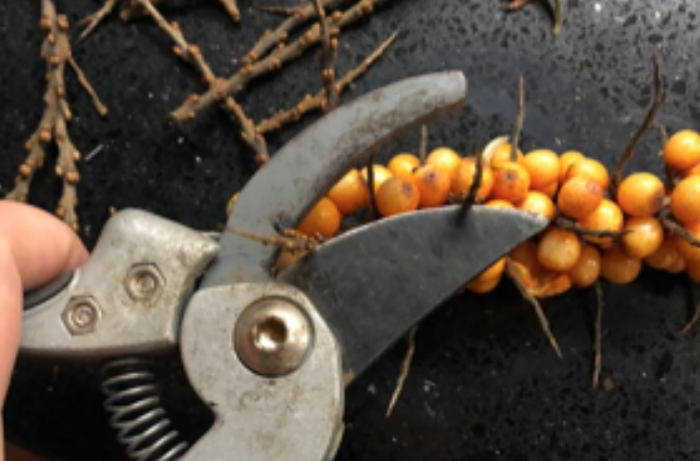Sea Buckthorn and Apple Chutney Recipe
A guest recipe by my friend and chutney guru James Mackenzie.
I’m extra delighted to have a post from James on here: apart from being a foragy chut-meister par excellence, he is also the tech-whizz who, about 10 years ago, said to me out of the blue, “Mark, you should share your foragy stuff on a blog”. Being a doer as well as a talker, twenty minutes later he had set me up with the first incarnation of this website. He then went on to patiently and generously give me leg-ups on my steep tech learning curve – which continues to this day.
At the same time, James also set me up an account on what was then a fairly new-fangled platform called Twitter, thereby launching me into social media, and in so doing playing midwife to the earliest days of cyber-foraging.
It’s these two actions that allowed me soon after to turn my hobby into a full-time job and source of so many good things in my life, and I am endlessly grateful to his warm and generous spirit (as well as his warm and generous spirits!)
James lives in Edinburgh, where he does most of his foraging with wonderfully efficient minimum of exertion, specialising in boozy infusions and spicy preserves. You can connect with him on his splendid Twitter account, where his favourite subjects are cats, chutney and (Scottish, Green) politics. or if you add comments below, I’ll make sure he sees them.
Mark Williams
Sea Buckthorn and Apple Chutney
Words and Images by James MacKenzie

Sea buckthorn and apple chutney. Image ©James Mackenzie
I love sea buckthorn. Mark got me into it, along with almost all the other stuff I love to forage. It grows prolifically along the East Lothian coast near Edinburgh, in quantities it would be near impossible for an army of foragers to over-harvest. As it happens its considered a problematic non-native invasive species around here, so over-harvesting is not so much an issue as avoiding spreading it to new locations.
I make chutney incessantly, so in the past I’ve added a little to my standard Christmas cranberry chutney. But to be honest, it got a little lost, although the berries kept their shape surprisingly well, and the wee gold flecks in the purple looked lovely.

Cooking the chutney, sea buckthorn berries added once the apple has softened. ©James Mackenzie
I then looked online for a recipe which would let these wonder-berries shine, and to be honest, having turned up a pretty disappointing set of options, I realised I would have to make my own. I started with quite a plain sea buckthorn, onion and chilli base, with sugar and vinegar. That turned out very thin, as I knew it would, so I gradually added in stewed apples until it tasted right. The apples give it more body and bind it together, but they don’t taste too strong and so don’t overwhelm the stars of the show. With a bit of tinkering, I finally got a ratio I’m really happy with. So here it is!
I should say that, in terms of harvesting sea buckthorn, I’m what Mark calls a “freezer” on his sea buckthorn page. And that’s really the only way to do it for this recipe. Cutting the damn thorns off before freezing the stems was a lesson learnt the hard way!

Trim thorns off berried twigs prior to freezing. ©James Mackenzie
I’m aware that this is a seasonal recipe … and as this goes live that is coming towards an end, but I’m certainly planning to make more next year. I expect seasoned foragers among you will have plenty in the freezer already.
Hope you enjoy it, and please let me know if you do variants of it.
Makes approximately 3kg of chutney (assumes 30% liquid loss)
- White onions 1,000g
- Cooking apple 1,300g (peeled and cored weight)
- Whole chipotles* x 4
- Chipotle powder* 1 tsp
- Caster sugar 700g
- White wine vinegar 900ml
- Sea buckthorn whole berries 550g
- Chop up the onions, apples and chipotles and stew over a medium heat with all the other ingredients except the sea buckthorn berries
- Cook until the apples start to lose their shape
- Add the sea buckthorn berries and continue to cook gently for 20 minutes, stirring as you go
- Let it cool then pour into clean jars (If you wish, sterilise the jars first, to a degree commensurate with your personal requirements around hygiene/keeping etc – though I don’t find this necessary)
- Should keep well out of the fridge until you open the jar – at which point store it in the fridge
*Note: I like it spicy – if you are heat-averse or unsure, use less chipotle, of course!
I like to eat it with a sharp cheese on an oatcake, alongside a more intense curry or dhal, or, for the adventurous, on a muffin with some vegan bacon (presumably also regular bacon, I can’t say, being vegy!)

Sea buckthorn and apple chutney is great on strong cheddar and oatcakes
Related Posts: